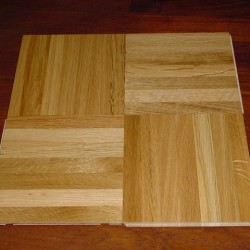Wood Parquet Tile Flooring
Wood parquet tile flooring is a sort of like a combination between hardwood flooring and vinyl tile squares; in a way, it is the best of both worlds. So it is kind of interesting that wood parquet tile flooring is not more popular, but there are some design issue involved here mentioned at the end of this article that may contribute to this.
Types of Wood Parquet Tile Flooring
There are two types of wood parquet tile flooring. The first type is solid wood, in which, as the name implies, the wood runs all the way from top to bottom. The other kind is a laminated wood parquet tile flooring, much like engineered flooring. This type has a stable plywood base upon which a finish veneer has been placed. Whether solid wood or engineered wood, both are available as unfinished or pre-finished products.
Still, it is a misnomer to call solid hardwood parquet truly solid. The reason for this is that parquet is composed of small pieces of wood and they must be combined together one way or another. So even this solid hardwood parquet does have a poly mesh or paper layer on the back. The reason manufacturers use a mesh is so that the tile will adhere to the adhesive better, much like the mesh on the back of mosaic tile.
Wood parquet tile is still an unusual flooring choice, so be careful if you expect to be selling the house anytime soon.
Newer types of wood parquet tile flooring have an attached underlayment of foam cushion, eliminating the need for you or the installer to put down separate underlayment. Not only does this underlayment act as a cushion, it is also self adhesive. Pull off the protecting paper, press down, and the parquet tile is stuck in place.
Of course, laminated wood flooring being what it is, there is also a parquet version of this, too. Since laminate is not wood, it really doesn’t even enter into this discussion about wood parquet tile.

Parquet Tile’s Tongue and Groove
One obvious advantage of parquet tile over something like vinyl or linoleum or other types of resilient tiling is that it comes with a tongue and groove system. All four edges of parquet tiles have either a tongue or groove, allowing them to be fit into place to the adjoining tile. This gives your new flooring greater stability. Otherwise, the floor would move around too much with foot traffic, adhesive or not.
Wood Parquet Tile Sizes
You can find parquet tiles in two typical sizes: 6″ x 6″ or 12″ x 12″. The 12 inch square parquet tile tends to be the most popular. Parquet tile comes rather thin, ranging from 5/16 of an inch to as much as three quarters of an inch, though this thicker size is rare.
Parquet Tile Design
Flooring designers recommend that you go easy with parquet tiling because it does tend to have a rather “busy” look about it. Using a solid decorative inlay border either along the perimeter of the floor or closer in towards the center of the floor is one way to cut this “busy” appearance. Parquet tiling may be appropriate for a room or two, but rarely do you find parquet installed throughout an entire house.